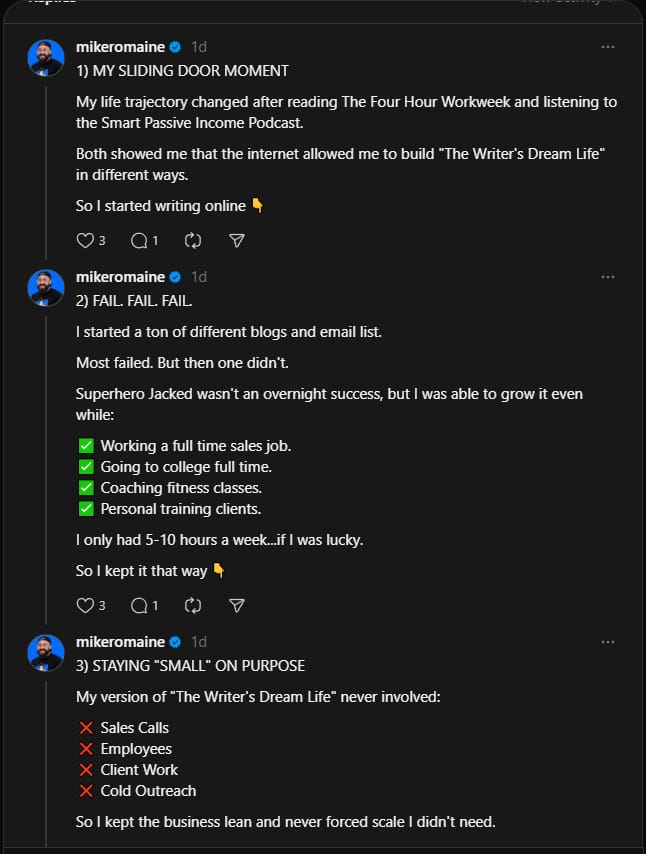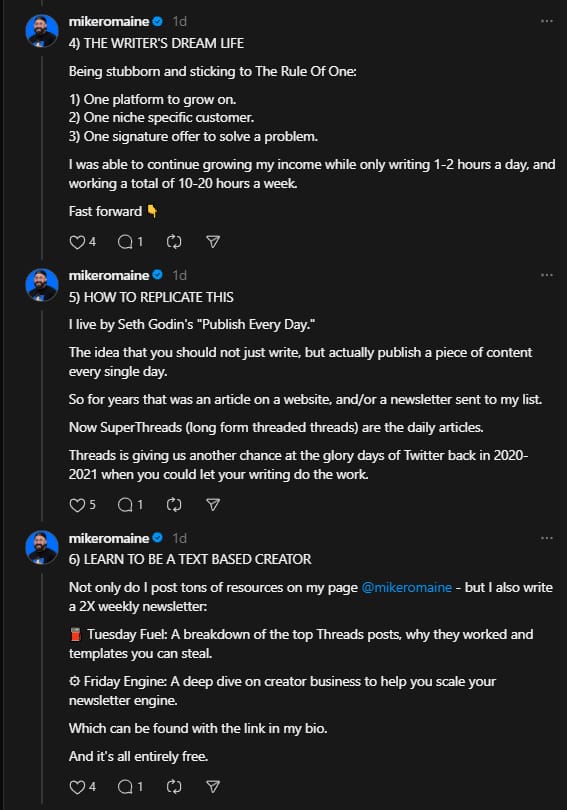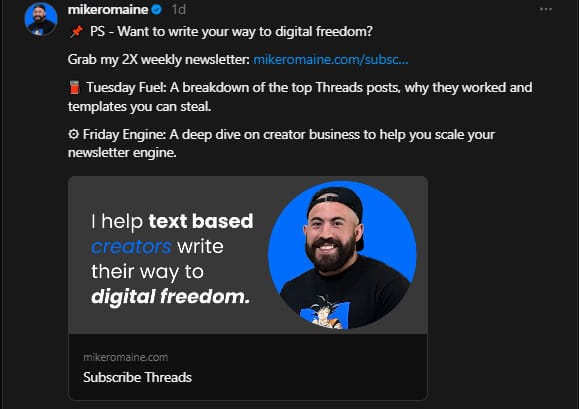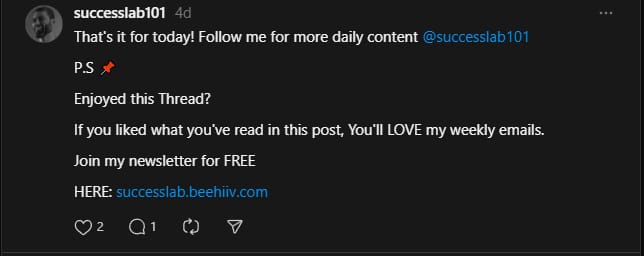- The Threads Creator Newsletter
- Posts
- How to nail your long-form posts
How to nail your long-form posts
Get better at writing long-forms in 5 minutes
Read time: ~4 mintues
Happy Sunday Creator!
Does your short-form posts gets tons of likes and views - But doesn’t give YOU any real value?
100+ likes on a post but barely any new follows, no leads, no connections built.
It feels like pointless attention.
Well I have, and that’s why:
I will write about something that has grown on me over the past months:
Long-form posts.
But first:
What is a long-form post?
A long-form post = A thread with multiple threads inside it
A short-form post = A single thread with no threads attached
I’ve started to include more long-form posts into my content strategy.
I’ve realized that long-form content simply gives more than short-form posts, they:
Build trust
Create connections
Build authority
The good thing about long-form posts, is the potential of the infinite value they can provide.
Since there isn’t a cap on how many threads you can have.
My current weekly goal is posting 5 long-form per week.
But writing long-form content isn’t easy - It takes more effort and thinkpower to write a successful long-form than a successful short-form.
In Todays newsletter I will teach you how to write effective long-form posts that builds:
Trust,
connections
authority
And of course views, likes and followers.
I will go through the different parts of a long-form thread and how to write them.
The 3 parts are:
The hook
The body
The offer (optional)
I’ll start with the hook
The hook
The hook determines if a post can go viral or not.
I like this saying from Mike Romaine: Think of the hook as a diet. You can have the best workout in the world and train hours a day, but without a good diet it means nothing.
The same goes for long-form posts.
You could have insanely good content inside your long-form.
But if the hook sucks, it's over
Think of it like the headline of a news article - It has to grab their attention instantly.
A great hook should be/do one or more of these things:
Create a curiosity-gap
Shock the reader
Bold statement
“scroll-stoper”
Tell a story
Curiosity-gap Example:
-“I gained 1,000 followers in 30 days,
here’s how.”
-"I’ve been growing on Threads for 11 months
and here’s the #1 thing I wish I knew earlier."
Shock Example:
-"Your long-form posts are failing
here’s why."
-"Why I stopped chasing followers
(and why you should too)."
-"90% of creators are wasting time on content that doesn’t convert.
Are you one of them?"
Bold statements:
-"Engagement doesn’t matter as much as you think
here’s what actually does."
-"You don’t need to post every day to grow
this is what works instead."
Storytelling Hooks:
-"11 months ago, I was stuck at 0 followers. Now, I’m at 11,400
this is my story."
"I failed at writing for months until I discovered this one framework."
"It took me 3,101 posts to learn this lesson about creating content."
Tip: I spend 50% of the effort on the hook, I rewrite, change the words, flip the order and so on.
If you want better results, Spend more time on the hook.
Main body
The rules for the main body is having a good structure and making it easy to read.
You want your valuable information to be easy to digest.
These 2 things usually goes hand in hand, if you have great structure, it’s usually easy to read.
And if it’s easy to read, it probably has a good structure.
A good structure can look very different from another good structure.
Meaning that there isn’t really a fit-all framework.
But there is of course some general rules:
Do not just write 500-word block of text with no headings or breaks. (500 words is the cap for a single thread)
Write in paragraphs and take advantage of bullet points and hyphens.
Write simple sentences that are easy to understand.
Use headlines and numbers
Here’s an example of good structure, a long-form post from @mikeromaine:


What makes this so good?
He starts every thread with a number and a headline in caps. Really effective formatting, I suggest everybody to try this.
He writes short sentences and “Writes like you talk”. This ensures that the information will be easy to read and digest.
He writes in paragraphs and leaves a blank row in-between the paragraphs. This makes it easier to read.
He takes advantage of lists and uses emojis instead of regular bullet points (doesn’t matter if you use emojis or bullet points).
He ends every thread with a “hook”. Makes the reader want to read more.
My advice to you:
Play around with different structures and see what works best.
Study the structures of big creators in your niche.
Plug-in Offer
Here’s when things starting to get exciting.
When you actually can make an offer.
A plug-in offer is a comment on the existing long-form post where you make an offer.
If done right, it won’t feel pushy or salesy - Instead, it feels like the natural next step for your audience.
It’s more likely that someone accepts your offer after you’ve given them free value.
Your offer can be something simple like asking the reader to follow you, or something bigger like subscribing to a newsletter or buying a product.
This is a plug-in offer from @mikeromaine (this feels like an ad for him haha):
He is offering the reader to join his newsletter.

Why did I choose to share this and why do I think it’s so good?
He starts of with “PS”. Studies has shown that readers are more likely to read the PS section out of any other part of a text.
He asks a simple question that is hard to say no to. This captures attention.
His CTA is simple and chose the word “Grab” instead of something basic like “Subscribe”
He tells the reader in short terms what they can expect if they join.
He has a nice picture attached to the link.
Example 2:
I’m sharing another Plug-in offer.
This is actually mine and a couple of people joined my newsletter from it.
I attached it to one of my long-forms:

This is not as specific as Mike’s was, so feel free to steal it or tweak it into your own!
Why You Shouldn’t Be Afraid of offers
Many creators hesitate to include offers because they worry about coming across as too “salesy.”
But here’s the thing:
If your post resonates, your audience wants to know what else you offer.
They’re already hooked on your insights - this is just the logical next step.
You’re not selling, you’re serving.
General tips and thoughts:
After you’ve read all this. You might ask yourself:
I know how to write a long-form post, but what in the hell should I write about?
My answer would be, anything that is valuable to your audience.
Actionable advice, Deep-dives, storys, frameworks and so on.
Providing value is the foundation of building trust and connection.
If you are a creator that wants to build a strong brand and eventually earn money.
Long-form posts are the way to go.
They build authority and you will be seen as a dominant creator in your niche
Summary:
Spend time and thinking power on the hook
Have a structure when you write
Provide as much value as you can
Write easy and clear
End with a Call-to-action
Writing a good long-form post is difficult, it takes some reps to get good at it.
Remember, writing 25+ long-form posts will teach you more than any newsletter or course will.
That’s it for today!
Have a nice Sunday and keep posting!
//SuccessLab
P.S If you haven’t got enough from me, here’s a few more ways I can help 👇️
Last week’s newsletter: YOU DON’T WANT TO MISS THIS
THREADS MASTERY: An actionable guide on how I went from 0 to 7,500 followers in 7 months. 18 pages of valuable tips + 25 viral content ideas ready to be stolen!
.